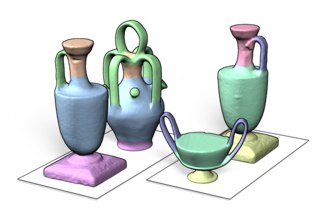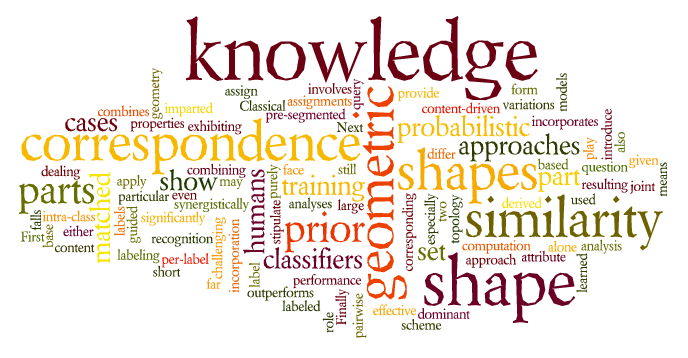
Figure: Meaningful correspondence between shape parts under significant geometric (right pair: missing mouth) and topological (both pairs: one vs. multiple handles) discrepancies is made possible by incorporating prior knowledge.
Classical approaches to shape correspondence base their computation purely on the properties, in particular geometric similarity, of the shapes in question. Their performance still falls far short of that of humans in challenging cases where corresponding shape parts may differ significantly in geometry or even topology. We stipulate that in these cases, shape correspondence by humans involves recognition of the shape parts where prior knowledge on the parts would play a more dominant role than geometric similarity. We introduce an approach to part correspondence which incorporates prior knowledge imparted by a training set of pre-segmented, labeled models and combines the knowledge with content-driven analysis based on geometric similarity between the matched shapes. First, the prior knowledge is learned from the training set in the form of per-label classifiers. Next, given two query shapes to be matched, we apply the classifiers to assign a probabilistic label to each shape face. Finally, by means of a joint labeling scheme, the probabilistic labels are used synergistically with pairwise assignments derived from geometric similarity to provide the resulting part correspondence. We show that the incorporation of knowledge is especially effective in dealing with shapes exhibiting large intra-class variations. We also show that combining knowledge and content analyses outperforms approaches guided by either attribute alone.

Figure 1: Part correspondence results via joint labeling. Aside from the failure cases in (j), (t), and (y), our method succeeded even under significant geometric and topological variations between the matched parts, while purely content-driven methods would fail. Corresponding segments between a pair of shapes are shown with the same color.

Figure 2: Joint labeling improves upon the use of prior knowledge alone. (a) and (c): correspondences obtained using probabilistic labels only, without content analysis. (b) and (d): results from joint labeling. The latter is effective in implying the correct correspondence for mislabeled parts when there is sufficient part-to-part similarity.
PPTX (9MB)
We thank Evangelos Kalogerakis for providing the dataset of labeled shapes and information on descriptor computation. We thank Xiaobai Chen for the segmentation benchmark, Daniela Giorgi and AIM@SHAPE for the meshes from the SHREC 2007 Watertight Track, and Ran Gal for additional man-made models. We also thank Lior Shapira and Shy Shalom for their help with the SDF. This work was supported in part by grants from the Israel Science Foundation founded by the Israel Academy of Sciences and Humanities, and the Natural Sciences and Engineering Research Council of Canada (NSERC).
@article{vankaick11knowledgecorresp,
author = {Oliver van Kaick and Andrea Tagliasacchi and Oana Sidi and Hao Zhang and Daniel Cohen-Or and Lior Wolf and and Ghassan Hamarneh},
title = {Prior Knowledge for Part Correspondence},
journal = {Computer Graphics Forum (Proc. Eurographics)},
volume = {30},
number = {2},
pages = {553--562},
year = 2011,
}
Related project: Unsupervised Co-Segmentation of a Set of Shapes via Descriptor-Space Spectral Clustering
GrUVi Project Page
